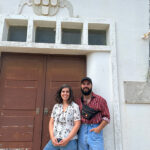By Hugh Carslaw
After sitting down to interview Ray Pocock, I am left thinking that he could easily feature on Piers Morgan’s Life Stories.
His biography features many world-famous names including Queen, David Bowie, and Placido Domingo. In many cases, he can be accredited with bringing them to the forefront of the music industry.
How he got there is not remotely the conventional route, but is equally as fascinating as the many major artists with whom he worked. On moving from Hastings to Luton at the age of 15, Ray found himself in conflict with his new headmaster, so he left school and joined the Royal Navy.
His time in the services was cut short due to his mother’s ill health, but a maritime career still beckoned. After a spell at the Navy training college at Sheerness, he spent two years in the Merchant Navy on cargo and passenger ships sailing to exotic locations such as the Caribbean and South America.
“I enjoyed the travel,” he tells me, but after two years at sea, Ray found himself working as a chef and also as a head wine waiter/sommelier before moving into retail.
“I always loved music, particularly the piano, but I was never going to be a professional performer. I could play the violin but I was left-handed so an orchestral career would have seen me poking the eyes out of a lot of fellow violinists,” he jokes. “But I was blessed with an excellent ear and reading music and scores was something I found easy – obviously essential for music production and recording.”
By the age of 23, Ray knew that he had to explore a career in music. “I saw an advert for a rep for RCA. I applied, got the job, and found myself selling records from the top artists of the day.” At that time vinyl recordings were being replaced by tapes and Ray found himself working as a tape product manager, before progressing to becoming Head of Pop Product for the UK. At that time, some of the main acts included Sweet, Renaissance and David Bowie. “The first hit I was responsible for was Chirpy Chirpy Cheep Cheep, by Middle of the Road – not a great claim to fame!”
The list of other bands with whom he worked at RCA is more impressive and includes; David Bowie, Mick Fleetwood, Bonnie Tyler, Sweet and Cleo Laine.
In 1978, he had a change of direction into classical music, a genre he also enjoyed. “ I found myself in a more administrative role looking after major classical artists, including the guitarist Julian Breem, Placido Domingo and oboist Malcolm Messiter.”
By 1979, Ray was Head of Classical and supervising and producing recordings for the LSO, including a series of works by Tchaikovsky. He was to become great friends with cellist Julian Lloyd Webber. “Julian is a real character. After the cello concerto premiere at the Festival Hall, the post-concert reception with art critics and the press was very intense, and all he wanted was a pint of real ale. ‘I know great pub around the corner,’ he told me and made me sneak off with him for a couple, not long into the reception. Julian also turned up at my wedding unannounced and sat down and played some unaccompanied Bach. A chamber choir I’d recorded also showed up. The vicar was not pleased, but I was delighted.”


It was at that time that James Galway, who had gone solo after leaving the Berlin Philharmonic, got in touch with Ray. “He told me he was listening to a John Denver album, really loved the songs but which one should he record? ‘I said Jimmy, what’s your wife’s name?` He chose Annie’s song! And I got a silver disc.”
In 1983, Ray decided to go freelance. RCA had opted to relocate their recording facilities from the HQ in Tottenham Court Road. “I negotiated a deal with them and took the recording equipment which was sitting unused and installed it in a large camper van to create a portable recording studio. One highlight was a recording with the Arditti String Quartet which won the Gramophone Award three times.
In 1985, Ray joined the Keith Prowse agency. “The aim was using sponsorship to generate great PR. My role was to negotiate and distribute sponsorship deals with music promoters. Over five years, Ray worked with over 20 of the top bands touring the UK including Status Quo, Depeche Mode, OMD and Randy Crawford to name a few. “Most memorable was working with Freddie Mercury on the tour which sadly ended up being his last.”
“I was invited to an after tour party after the final gig by Bon Jovi at the Borderline restaurant in Hammersmith. The restaurant was pretty full, so I grabbed a table near the front door with my son and a few others. After a while, this guy comes in, looks around, and sees a space at our table. He came over to me and said ‘Mind if I join you Ray?’ The look on the other guys’ faces was priceless when Brian May sat down to join us.”
The list of celebrities who Ray has met over the years starts with Alan Freeman and includes countless pop artists such as Elkie Brooks, Bryan Ferry and Randy Crawford. Harry Nilsson owed him a packet of cigarettes after they shared a cab and a couple of pints. On the classical side, he had afternoon tea with legendary pianist Arthur Rubinstein and was invited to Placido Domingo’s 40th birthday party.
Ray has not stopped work entirely, as he is still involved in graphic design, mainly for pubs and restaurants. He can look back on his career with many fond memories. This writer looks forward to sitting down with him again to hear more tales from his amazing journey through life.
Some behind-the-scenes imagery from a recent shoot she did here in the Algarve.













